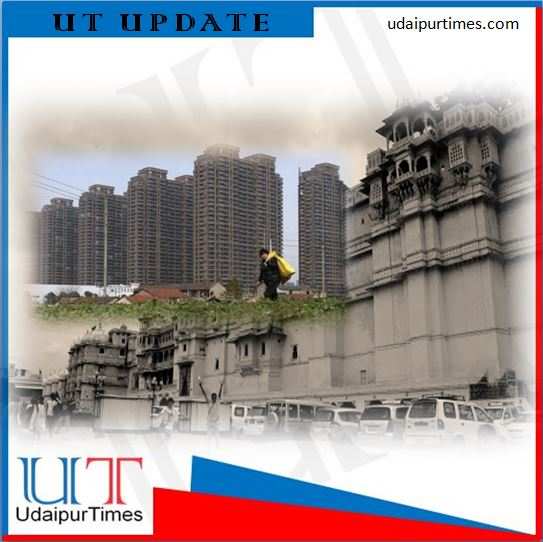Udaipur - a case of peri-urban development | Needs restructuring in its peri-urban growth
There exists a vast difference between the projected spatial urban sprawl and the reality in which urban transitions happen. Indian cities have witnessed socio-temporal patterns of land use and suitability in its urban fringes. The presence of land resource, economic opportunities and development potential leads to the chain reaction of urban processes and emergence of newer patterns of sprawl in the peripheral areas.
From 1946 to 2011, Udaipur has grown from 17 sq. km to 221 sq. km. With almost 25% land in the urban limits is left for the allocation of plots for residential purpose. Udaipur has witnessed its urban sprawl in four major directions – South and South-East towards Ahmedabad highway, East towards Chittorgah, North-East towards Nathdwara. All these areas have witnessed tremendous growth of residential population and industries. The presence of major arteries has helped the newer urban forms to mushroom within these areas. Most of them lie in the notified urban area but not into the municipal limits. Thus, they have been included in the master plan document but necessarily need not be given equal dearth as that of existing urban limits.
While tracing the transition of urban landscape in Udaipur in last 10 years, one can see the development of plotted colonies, high rises, projects for EWS-LIG under various schemes and mixed land use typology in areas near Bhuwana, Chitrakoot nagar, Govardhan vilas, Teetardi, Umarda and Transport nagar to name a few. The rise in speculative land prices and presence of amenities has made these areas a hot spot for investment, thus triggering Gentrification. The proposed bypass connecting Sukher via Debari to Balicha has paved way for various institutions like Pacific Hospital, Geetanjali college and hospital, schools and colleges like IIM Udaipur, Padmawat Singhania, Techno NJR, Forum celebration mall, Urban square (promoted as Rajasthan’s biggest mall), Resorts, Hotels, Khelgaon to attract residents in their vicinity. Apart from industrial economy, these places have helped establish a thriving service economy for the city and residents.
These newer urban forms and processes have not been smoother in planning and execution. The process of development in the urban fringes has been influenced by the lobby of developers instead of urban planners and urban designers. It is the market driven approach to create high rises, star facility amenities, luxury retail and commercial centres; creating a situation of mobilization of people and economic processes from the city center. The process of land acquisition and green field development are chaotic as there seems to be a ruckus as per the proposed zoning and land use. Intermediary zones overlapping rural and urban jurisdictions are re - imagined as a multi-functional territory; engaging populations in mixed land use and high end economic opportunities and services. The rise in speculative land prices, hoarding of land in the name of investment, loss in agricultural land and plantations, absence of active public transportation system, incompetent planning are a few issues that have boiled up due to chaotic peri-urban development in Udaipur.
The Master plan 2031 document shows the proposed land use for many of these areas. However, the municipal limit is much different than the planning zone. Thus, this creates a situation where an urban local body has prepared plans for areas administrated under a rural body. This is one of the major reasons why chaotic development takes place on urban peripheries. The urban governance and urban local bodies will reflect the changes once these areas are included in the municipal limits. At present, though there is the presence of statutory development plans, laws and land use maps, the planning is fragmented and uncontrolled. Lack of clarity in development control and urban by laws also results in socio-economic disparity and by passing of sprawl. Deficiencies in planning and governance has left these areas open for the rampant construction of illegal structures by individuals and groups. Private real estate developers are also able to convince villagers with attractive prices to acquire, gain control and hold agricultural land, and carry out illegal sub-division and disposal when land values increase. There are cases of peri-urban areas being colonised by private builders and public sector agencies that cater only to the interests of influential groups.
To conclude, Udaipur needs a restructuring in its unregulated peri urban growth. There is a need for rational regional plan with focus on affordable housing, public transportation and public amenities. It should unfold the question of impending labour and informality, agriculture and livestock, industry and affordable housing and commute to city center. Formulating an effective regulatory regime and peri urban planning agencies can aid in inclusive rural-urban cluster development. Local area plan and Area based development for these peri urban areas must be mandated through master plan; creating an equal and enforced vision and planning document.
About the Author
Trained as an Architect (Honors in B. arch, Gold medallist; JNVU) and an Urban designer (kRVIA), Daksh Jain is a resident of Udaipur. His interests traverse in the domain of Urban planning, Urban design, Heritage conservation, Development finance and Policy framework. His works in academia follows the lines of Sociology, Ecology, Economics, Cultural studies, Informality and inclusive public oriented designs.
Currently, he is working as an independent researcher on the topic- City life, Culture and Consumption – Emerging urban phenomena.
He is also the recipient of Bhamashah Award for excellence in Academics by Eternal Mewar,Maharana Mewar Foundation in 2019.
To join us on Facebook Click Here and Subscribe to UdaipurTimes Broadcast channels on GoogleNews | Telegram | Signal



